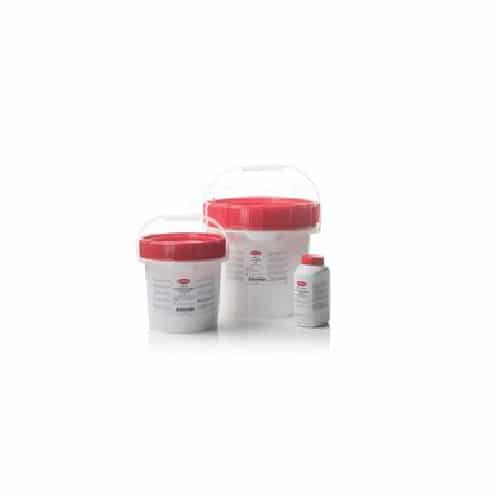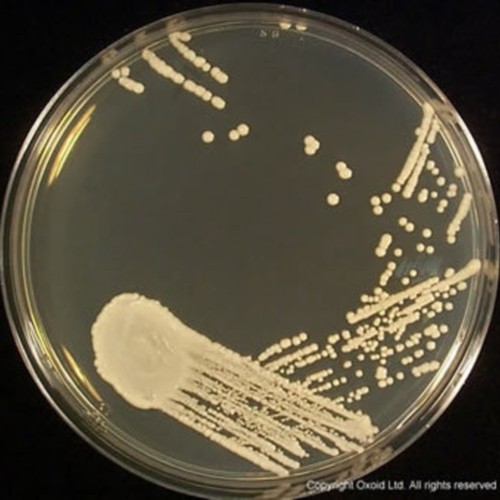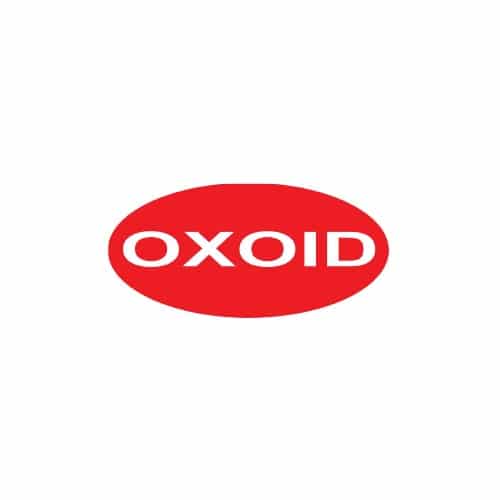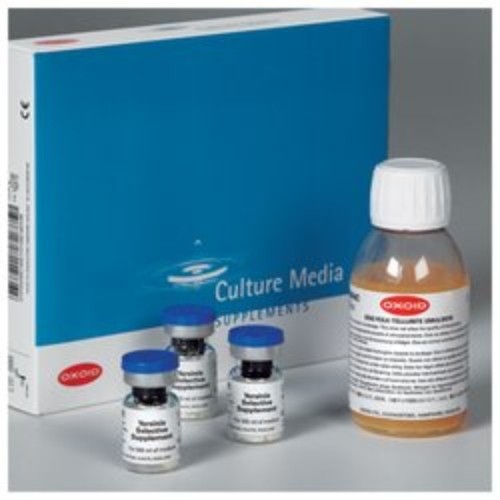
Malt Extract Broth 500g
Login to see pricesBrand:
Thermo ScientificTM OxoidTM
Oxoid Malt Extract Broth is used for the identification of yeast and molds in sterility testing.
Malt Extract Broth, Oxoid Composition
| Typical Formula* |
gm/litre |
| Malt extract |
17.0 |
| Mycological peptone |
3.0 |
| pH 5.4 ± 0.2 |
|
Malt Extract Broth, Oxoid Preparation:
Add 20g to 1 litre of distilled water. Mix well, distribute into final containers and sterilise by autoclaving at 115°C for 10 minutes. This liquid medium is recommended for the cultivation of moulds and yeasts, during tests for sterility, etc.
Storage conditions and Shelf life
Store the dehydrated medium at 10-30°C and use before the expiry date on the label.
Store the prepared medium at 2-8°C.

Blood Agar Base 500g
Login to see pricesBrand:
Thermo ScientificTM OxoidTM
Oxoid Blood Agar Base is a nonselective general purpose medium which may be enriched with blood or serum.
Blood Agar Base, Oxoid Composition
| Typical Formula* |
gm/litre |
| `Lab-Lemco’ powder |
10.0 |
| Peptone Neutralised |
10.0 |
| Sodium chloride |
5.0 |
| Agar |
15.0 |
| pH 7.3 ± 0.2 |
Blood Agar Base, Oxoid Preparation:
Suspend 40g in 1 litre of distilled water. Bring to the boil to dissolve completely. Sterilise by autoclaving at 121°C for 15 minutes.
For blood agar, cool the Base to 50°C and add 7% of Defibrinated Horse Blood SR0050. Mix with gentle rotation and pour into petri dishes or other containers.
Storage conditions and Shelf life
Store the dehydrated medium at 10-30°C and use before the expiry date on the label.
Store the prepared plates of medium at 2-8°C.
Precautions
The haemolytic reactions of organisms inoculated on to this medium will be affected by the animal blood used e.g. horse or sheep and the incubation conditions e.g. aerobic, capnoeic or anaerobic.
When horse blood is added to the medium Haemophilus haemolyticus colonies will produce beta-haemolysis and mimic Streptococcus pyogenes.

Urea Agar Base 500g, Oxoid
Login to see pricesBrand:
Thermo ScientificTM OxoidTM
Oxoid Urea Agar Base (Christensen Agar Base) is used for detection of urease-producing microorganisms.
Urea Agar Base, Oxoid Composition
| Typical Formula* |
gm/litre |
| Peptone |
1.0 |
| Glucose |
1.0 |
| Sodium chloride |
5.0 |
| Disodium phosphate |
1.2 |
| Potassium dihydrogen phosphate |
0.8 |
| Phenol red |
0.012 |
| Agar |
15.0 |
| pH 6.8 ± 0.2 |
|
Urea Agar Preparation:
Suspend 2.4g in 95ml of distilled water. Bring to the boil to dissolve completely. Sterilise by autoclaving at 115°C for 20 minutes. Cool to 50°C and aseptically introduce 5ml of sterile 40% Urea Solution SR0020. Mix well, distribute 10ml amounts into sterile containers and allow to set in the slope position.
Storage conditions and Shelf life
Store the dehydrated medium at 10-30°C and use before the expiry date on the label.
Store the prepared medium at 2-8°C.
Precautions
The alkaline reaction produced in this medium after prolonged incubation may not be caused by urease activity. Check using medium without urea.
Do not heat or reheat the medium because urea decomposes very easily.
For the detection of urease-positive Proteae the reaction must be read within the first 2-5 hours of incubation.

MRVP Medium 500g, Oxoid
Login to see pricesBrand:
Thermo ScientificTM OxoidTM
Oxoid MRVP Medium. A glucose-phosphate medium is used for the differentiation of the coli-aerogenes group by the Methyl Red and Voges-Proskauer tests.
MRVP Medium, Oxoid Composition
| Typical Formula* |
gm/litre
|
| Peptone |
7.0 |
| Glucose |
5.0 |
| Phosphate buffer |
5.0 |
| pH 6.9 ± 0.2 |
|
MRVP Medium, Oxoid Preparation:
Add 17g to 1 litre of distilled water. Mix well, distribute into final containers and sterilise by autoclaving at 121°C for 15 minutes.
Storage conditions and Shelf life
Store the dehydrated medium at 10-30°C and use before the expiry date on the label.
Store the prepared medium at 2-6°C.
Precautions
The MR-VP reactions are only part of the tests required to identify organisms.
Each laboratory should standardise on the inoculum density, volume of broth and the test container size.
MR tests require a minimum incubation of 48 hours before the pH indicator is added.
When using Barritt’s reagents add a-naphthol first and KOH second; do not reverse this order.
Vaughn et al. warned of false positive VP reactions if the completed tests are left standing for over an hour.

Sabouraud Dextrose Agar 500g, Oxoid
Login to see pricesBrand:
Thermo ScientificTM OxoidTM
Identify dermatophytes and other fungi and yeasts in clinical specimens and environmental samples with the acidic Thermo Scientific™ Oxoid™ Sabouraud Dextrose Agar. The low pH supports the growth of fungi while inhibiting bacterial growth in mixed samples. Fungi maintain their typical cultural appearance and, thus, may be readily identified according to standard macroscopic characters.
| Typical Formula * |
gm/litre
|
| Mycological Peptone |
10.0 |
| Glucose (dextrose) |
40.0 |
| Agar |
15.0 |
| pH 5.6 ± 0.2 @ 25°C |
Directions
Add 65g of Sabouraud Dextrose Agar to 1L of distilled water. Sterilize the medium by autoclaving at 121°C for 15 mins. Mix well and pour into a clean petri dish.
Storage Conditions and Shelf Life
Store the medium at 10-30°C and use before the expiry date printed on the label. Store the prepared medium at 2-8°C.

Desoxycholate Citrate Agar 500g
Login to see pricesBrand:
Thermo ScientificTM OxoidTM
Oxoid Desoxycholate Citrate Agar is a differential medium for enumeration of coliforms and the isolation of enteric pathogens.
Desoxycholate Citrate Agar, Oxoid Composition
| Typical Formula* |
gm/litre |
| Lab-Lemco’ powder |
5.0 |
| Peptone |
5.0 |
| Lactose |
10.0 |
| Sodium citrate |
5.0 |
| Sodium thiosulphate |
5.0 |
| Ferric citrate |
1.0 |
| Sodium desoxycholate |
2.5 |
| Neutral red |
0.025 |
| Agar |
15.0 |
| pH 7.0 ± 0.2 |
Desoxycholate Citrate Agar, Oxoid Preparation:
Suspend 48.5g in 1 litre of distilled water. With frequent agitation bring to the boil over a gauze and flame to dissolve completely. Mix well and pour plates immediately. Dry the agar surface before use.
THIS MEDIUM IS HEAT SENSITIVE. AVOID EXCESSIVE OR PROLONGED HEATING DURING RECONSTITUTION. DO NOT AUTOCLAVE, OR REMELT.
Storage conditions and Shelf life
Store the dehydrated medium at 10-30°C and use before the expiry date on the label.
Store the prepared agar plates at 2-8°C.
Precautions
The medium is best used freshly prepared.
Stock cultures of Shigella species may become predominantly in the R-phase when subcultured away from DCA media. Such cultures are difficult to use for control purposes without first heavily streaking the cultures on DCA plates and picking off the few S-phase colonies i.e. the macro-colonies on the agar surface, for further subculture.
When making biochemical tests on colonies picked from the surface of DCA plates, purity subcultures should be carried out because the colony may be contaminated with Escherichia coli present as micro-colonies.

Kligler Iron Agar 500g, Oxoid
Login to see pricesBrand:
Thermo ScientificTM OxoidTM
Oxoid Kligler Iron Agar is used for differential identificaton of Enterobacteriaceae.
Kligler Iron Agar, Oxoid Composition
| Typical Formula* |
gm/litre |
| `Lab-Lemco’ powder |
3.0 |
| Yeast extract |
3.0 |
| Peptone |
20.0 |
| Sodium chloride |
5.0 |
| Lactose |
10.0 |
| Glucose |
1.0 |
| Ferric citrate |
0.3 |
| Sodium thiosulphate |
0.3 |
| Phenol red |
0.05 |
| Agar |
12.0 |
| pH 7.4 ± 0.2 @ 25°C |
Kligler Iron Agar, Oxoid Preparation:
Suspend 55g in 1 litre of distilled water. Bring to the boil to dissolve completely. Mix well and distribute into containers. Sterilise by autoclaving at 121°C for 15 minutes. Allow to set as slopes with 1 inch butts.
Storage conditions and Shelf life
Store the dehydrated medium at 10-30°C and use before the expiry date on the label.
Store the prepared medium at 2-8°C.
Precautions
It is essential that Kligler Iron Agar is examined and reported at 18-24 hours. Early or late readings will give false results.
KIA will grow both oxidative and fermentative organisms. Confusion will result if care is not taken to distinguish between the two groups.
Always use a straight wire to inoculate the butt, to avoid splitting the agar with a loop.
Pure cultures are essential to avoid misinterpretation.
Do not use screw-capped tubes or bottles for KIA medium. It is essential that air is freely available to growth on the slant.

Brilliant Green Bile 2% Broth 500g, Oxoid
Login to see pricesBrand:
Thermo ScientificTM OxoidTM
Oxoid Brilliant Green Bile Broth 2% is used for detection or confirmation of presence of members of coli-aerogenes group.
- Recommended for 44°C confirmatory test for Escherichia coli
Brilliant Green Bile Broth 2%, Oxoid Composition
| Typical Formula * |
gm/litre |
| Peptone |
10.0 |
| Lactose |
10.0 |
| Ox bile (purified) |
20.0 |
| Brilliant green |
0.0133 |
| pH 7.4 ± 0.2 @ 25°C |
Brilliant Green Bile Broth 2%, Oxoid Preparation:
Dissolve 40g in 1 litre of distilled water. Mix well, distribute into containers fitted with Durham’s tubes and sterilise by autoclaving at 121°C for 15 minutes.
Do not autoclave double stregnth medium. The alternative procedure is to heat the dissolved broth at 100°C for 30 minutes.
Storage conditions and Shelf life
Store the dehydrated medium at 10-30°C and use before the expiry date on the label.
Store the prepared tubes of broth at 2-8°C.
Precautions
Do not autoclave double-strength broth.
Gram-positive sporing organisms may produce gas if the bile/brilliant green inhibition is attenuated by food material.

Tetrathionate Broth Base 500g, Oxoid
Login to see pricesBrand:
Thermo ScientificTM OxoidTM
Oxoid Tetrathionate Broth Base is used for selective enrichment of Salmonella species.
Tetrathionate Broth Base, Oxoid Composition
Add 77g to 1 litre of distilled water and bring to the boil. Cool below 45°C and add 20ml of iodine solution. Mix well and tube in 10ml quantities. The prepared base will keep for several weeks at 4°C but should be used soon after the addition of the iodine solution.
Iodine Solution
| Iodine |
6 grams |
| Potassium iodide |
5 grams |
| Distilled water |
20ml |
Tetrathionate Broth Preparation:
Tetrathionate Broth is recommended for the selective enrichment method of isolating Salmonella typhi and other salmonellae from faeces, sewage, etc.
Organisms which reduce tetrathionate, such as salmonellae, flourish in the medium whilst many faecal organisms are inhibited. Members of the Proteus group reduce tetrathionate and may consequently impair the value of this medium for the isolation of salmonellae; this disadvantage of the medium is largely overcome by the addition of 40µg of novobiocin to each millilitre of the incomplete medium before the addition of iodine.
Storage conditions and Shelf life
Store the dehydrated medium at 10-30°C and use before the expiry date on the label.
Store the prepared medium (without iodine solution) at 2-8°C.

Edwards Medium (Modified) 500g, Oxoid
Login to see pricesBrand:
Thermo ScientificTM OxoidTM
Oxoid Edwards Medium, Modified is used for selective isolation of Streptococcus agalactiae.
Edwards Medium, Modified, Oxoid Composition
| Typical Formula* |
gm/litre |
| `Lab-Lemco’ powder |
10.0 |
| Peptone |
10.0 |
| Aesculin |
1.0 |
| Sodium chloride |
5.0 |
| Crystal violet |
0.0013 |
| Thallous sulphate |
0.33 |
| Agar |
15.0 |
| pH 7.4 ± 0.2 |
|
Edwards Medium, Modified, Oxoid Preparation:
Suspend 41g in 1 litre of distilled water. Bring to the boil to dissolve completely. Sterilise by autoclaving at 115°C for 20 minutes. Cool to 50°C, add 5-7% of sterile bovine or sheep blood, mix well and pour plates.
Storage conditions and Shelf life
Store the dehydrated medium at 10-30°C. and use before the expiry date on the label.
Store the prepared plates at 2-8°C.

Thioglycollate Medium (Brewer) 500g, Oxoid
Login to see pricesBrand:
Thermo ScientificTM OxoidTM
This product has been discontinued. The alternative product is Thioglycollate Fluid Medium USP (CM0173).
Oxoid Thioglycollate Medium, Brewer is an anaerobic medium especially useful for sterility control of solutions containing mercury-based preservatives.
Thioglycollate Medium, Brewer, Oxoid Composition
| Typical Formula* |
gm/litre |
| `Lab-Lemco’ powder |
1.0 |
| Yeast extract |
2.0 |
| Peptone |
5.0 |
| Glucose |
5.0 |
| Sodium chloride |
5.0 |
| Sodium thioglycollate |
1.1 |
| Methylene blue |
0.002 |
| Agar |
1.0 |
| pH 7.2 ± 0.2 |
Thioglycollate Medium, Brewer, Oxoid Preparation:
Suspend 20g in 1 litre of distilled water. Bring to the boil, mix well and allow to stand until completely dissolved. Distribute into final containers and sterilise by autoclaving at 121°C for 15 minutes.
Media containing small quantities of agar are liable to separate if cooled rapidly. Tubes of reconstituted and autoclaved medium should be allowed to cool slowly on a wooden surface in a draught-free atmosphere.
Storage conditions and Shelf life
Store the dehydrated medium at 10-30°C and use before the expiry date on the label.
The prepared medium should be stored away from light at room temperature.
Precautions
Check the upper portion of the prepared medium before inoculation. If more than one-third of the fluid is oxidised i.e. green coloured, discard the bottle.
If one-third or less fluid is oxidised, then heat in boiling water with the cap loosened to drive off oxygen. Cool to room temperature before inoculation. This reheating process can only be carried out once because of the formation of toxic radicles in the medium.
Organisms which ferment glucose and lower the pH to critical levels may not survive in this medium after growth has taken place.

Milk Agar 500g, Oxoid
Login to see pricesBrand:
Thermo ScientificTM OxoidTM
Oxoid Milk Agar, Oxoid is for use in the dairy industry.
Milk Agar, Oxoid Composition
| Typical Formula* |
gm/litre |
| Yeast extract |
3.0 |
| Peptone |
5.0 |
| Milk solids (equivalent to 10ml fresh milk) |
1.0 |
| Agar |
15.0 |
| pH 7.2 ± 0.2 @ 25°C |
Milk Agar, Oxoid Preparation:
Suspend 24g in 1 litre of distilled water. Bring to the boil to dissolve completely. Sterilise by autoclaving at 121°C for 15 minutes.
Storage conditions and Shelf life
Store the dehydrated medium at 10-30°C and use before the expiry date on the label.
Store the prepared medium at 2-8°C.

Yeast Extract Agar 500g, Oxoid
Login to see pricesBrand:
Thermo ScientificTM OxoidTM
Carry out plate counts of microorganisms in water with Thermo Scientific™ Oxoid™ Yeast Extract Agar (Dehydrated). Yeast Extract Agar is made to the formula described by Windle Taylor for the plate count of microorganisms in water and is tested in accordance with ISO 1133:2014. It is a rich, nutritious medium for the recovery of a wide range of bacteria, yeast, and molds.
Yeast Extract Agar, Oxoid Composition
| Typical Formula* |
gm/litre |
| Yeast extract |
3.0 |
| Peptone |
5.0 |
| Agar |
15.0 |
| pH 7.2 ± 0.2 @ 25°C |
Yeast Extract Agar, Oxoid Preparation:
Suspend 23g in 1 litre of distilled water. Bring to the boil to dissolve completely. Sterilise by autoclaving at 121°C for 15 minutes.
Storage conditions and Shelf life
Store the dehydrated medium at 10-30°C and use before the expiry date on the label.
Store the prepared medium at 2-8°C.

Lab Lemco Agar 500g
Login to see pricesBrand:
Thermo ScientificTM OxoidTM
Oxoid Lab-Lemco Agar (Nutrient Agar) is a nutrient medium for general bacteriological use.

Lab-Lemco Broth 500g
Login to see pricesBrand:
Thermo ScientificTM OxoidTM
Oxoid Lab-Lemco Broth is a nutrient medium equivalent to USA nutrient extract formulations.
Lab-Lemco Broth, Oxoid Composition
| Typical Formula* |
gm/litre |
| `Lab-Lemco’ powder |
3.0 |
| Peptone |
5.0 |
| pH 7.4 ± 0.2 |
|
Lab-Lemco Broth, Oxoid Preparation:
Dissolve 8g in 1 litre of distilled water and distribute into final containers. Sterilise by autoclaving at 121°C for 15 minutes.
Storage conditions and Shelf life
Store the dehydrated medium at 10-30°C and use before the expiry date on the label.
Store the prepared medium at room temperature.
`Lab-Lemco’ Broth is slightly more alkaline than the medium used in the APHA publications (pH 6.8).

Peptone Water 500g, Oxoid
Login to see pricesBrand:
Thermo ScientificTM OxoidTM
Peptone water (CM0009B), Oxoid, is a basal medium that used as a growth medium or as the basis of carbohydrate fermentation media. A pure culture in Peptone Water is a convenient inoculum for a series of fermentation tubes or other diagnostic media.
| Typical Formula* |
gm/litre |
| Peptone |
10.0 |
| Sodium Chloride |
5.0 |
| pH 7.2 ± 0.2 @ 25°C |
Directions
Add 15g to 1 litre of distilled water. Mix well and distribute into final containers. Sterilise by autoclaving at 121°C for 15 minutes.
Storage conditions and Shelf life
Store the dehydrated medium at 10-30°C and use before the expiry date on the label.
Store the prepared medium below 25°C.

MacConkey Agar 500g, Oxoid
Login to see pricesBrand:
Thermo ScientificTM OxoidTM
MacConkey agar, Oxoid is used to detect, isolate and enumerate coliforms and intestinal pathogens in water, dairy products and biological specimens. This differential medium gives a number of diagnostic indications such as bile tolerance, colony morphology and chromogenesis. MacConkey Agar corresponds to the medium recommended by the World Health Organizaton, the Department of Health for the bacterial examination of water.
Composition of MacConkey Agar (Oxoid)
| Typical Formula * |
gm/litre
|
| Peptone |
20.0 |
| Lactose |
10.0 |
| Bile Salts |
5.0 |
| Sodium chloride |
5.0 |
| Neutral red |
0.075 |
| Agar |
12.0 |
| pH 7.4 ± 0.2 @ 25°C |
Preparation of MacConkey Agar (Oxoid):
Suspend 52g of MacConkey agar powder in 1 litre of distilled water. Bring to the boil to dissolve completely. Sterilise by autoclaving at 121°C for 15 minutes.
Storage conditions and Shelf life of MacConkey Agar (Oxoid)
Store the dehydrated MacConkey agar powder at 10-30°C and use before the expiry date on the label.
Store the prepared MacConkey agar at 2-8°C.

MacConkey Broth 500g
Login to see pricesBrand:
Thermo ScientificTM OxoidTM
Identify coliforms from water and milk samples with differential Thermo Scientific™ Oxoid™ MacConkey Broth (Dehydrated). MacConkey Broth is the standard medium for the primary isolation of coliform bacteria, and has been recommended for this purpose by the Public Health Laboratory Service Water Committee and the World Health Organization. MacConkey Broth also conforms to the formulation specified by the UK Dept. of Health for milk grading.
MacConkey Broth, Oxoid Composition
| Typical Formula* |
gm/litre |
| Peptone |
20.0 |
| Lactose |
10.0 |
| Bile salts |
5.0 |
| Sodium chloride |
5.0 |
| Neutral red |
0.075 |
| pH 7.4 ± 0.2 |
MacConkey Broth, Oxoid Preparation:
To prepare single strength broth, add 40g to 1 litre of distilled water. Mix well and distribute into containers fitted with fermentation (Durham) tubes. Sterilise by autoclaving at 121°C for 15 minutes.
Storage conditions and Shelf life
Store the dehydrated medium at 10-30°C and use before the expiry date on the label.
Store the prepared medium at 2-8°C.
Precautions
The neutral red indicator is carefully selected for this formulation and therefore shows no inhibitory effect. However, the more sensitive reaction of bromocresol purple in MacConkey Broth Purple (CM0505) is often preferred.

Nutrient Agar Tablets (100’S)
Login to see pricesBrand:
Thermo ScientificTM OxoidTM
Oxoid Nutrient Agar Tablets make 5mL of medium each.
Nutrient Agar Tablets, Oxoid Composition
| Typical Formula * |
gm/litre
|
| `Lab-Lemco’ powder |
1.0 |
| Yeast extract |
2.0 |
| Peptone |
5.0 |
| Sodium chloride |
5.0 |
| Agar |
15.0 |
| pH 7.4 ± 0.2 @ 25°C |
Nutrient Agar, Oxoid Preparation:
Add one tablet to 5ml of distilled water and soak for 5 minutes. Sterilise by autoclaving at 121°C for 15 minutes.
Storage conditions and Shelf life
Store the dehydrated medium at 10-30°C and use before the expiry date on the label.
Store the prepared medium at 2-8°C.

Nutrient Broth 500g, Oxoid
Login to see pricesBrand:
Thermo ScientificTM OxoidTM
Nutrient Broth (500g, Oxoid) is a general-purpose growth medium for bacteria. For any special purpose, you can add blood, serum, sugars, etc.
Composition of Nutrient Broth, Oxoid
| Typical Formula* |
gm/litre |
| ‘Lab-Lemco’ powder |
1.0 |
| Yeast extract |
2.0 |
| Peptone |
5.0 |
| Sodium chloride |
5.0 |
| pH 7.4 ± 0.2 @ 25°C |
Preparation of Nutrient Broth, Oxoid
Add 13g of nutrient broth to 1 litre of distilled water. Mix well and distribute into final containers. Sterilise by autoclaving at 121°C for 15 minutes.
Storage conditions and Shelf life
Store the dehydrated medium at 10-30°C and use before the expiry date on the label.
Store the prepared medium below 25°C.

Co2gen 10/Pck
Login to see pricesBrand:
Thermo ScientificTM OxoidTM
Generate carbon dioxide atmosphere in AnaeroJar™ 2.5L with Oxoid CO2 Gen Sachet.
- No water or catalyst required
- No hydrogen gas produced

Co2gen Compact 20/Pck
Login to see pricesBrand:
Thermo ScientificTM OxoidTM
Oxoid CO2 Gen Compact Sachet is for use in Compact Plastic Pouch.
- No water or catalyst required
- No hydrogen gas produced
- For use with Compact Plastic Pouch, Part No. AG0020C and AnaeroGen Compact Sealing Clip, Part No. AN0005C

Oxoid M.U.G. Supplement 1 X 10 Vials
Login to see pricesBrand:
Thermo ScientificTM OxoidTM
Oxoid MUG Supplement (50mg) Fluorescent agent is used for the detection of E. coli.
- Contains 4-methylumbelliferyl-β-D-glucuronide (MUG)
- Each vial supplements 500mL of medium
M.U.G. Supplement, Oxoid Composition
| Vial content | |
| 4-methylumbelliferyl-ß-D-glucuronide | 50mg |
M.U.G. Supplement, Oxoid Preparation:
Add 2ml of distilled water to a vial and invert gently until completely dissolved. Add the vial contents to the following volumes of suggested media, before sterilisation.
| Medium |
Final conc. of MUG per litre |
Number of vials per litre |
| Violet Red Bile Agar CM0107 |
100mg |
2 |
| MacConkey Agar No. 3 CM0115 |
100mg |
2 |
| Brilliant Green Bile (2%) Broth CM0031 |
50mg |
1 |
| MacConkey Broth Purple CM0505 |
50mg |
1 |
| Lauryl Tryptose Broth CM0451 |
50mg |
1 |
Storage conditions and Shelf life
Should be stored at 2-8°C. When stored as directed the unopened vial is stable until the expiry date on the label.
Precautions
The presence of endogenous glucuronidase in shellfish samples may result in false positive fluorescence. Test tubes used in the MPN method should be checked under UV light to ensure the glass does not fluoresce. To avoid false positive fluorescence the source of long wave UV light must not exceed 6 watts.

Oxoid Resazurin Anaerobic Indicator
Login to see pricesBrand:
Thermo ScientificTM OxoidTM
Oxoid Resazurin anaerobic indicator is an indicator strip for use with anaerobic jar systems, AnaeroJar 2.5L and AnaeroGen, 2.5L. When this anaerobic indicator strip changes from red to white, you can ensure the anaerobic condition is well generated.



